Locomotives
Steam

Status: Operational
Built by John Fowler & Company at Leeds England in 1909, this locomotive arrived in Australia in mid 1909. It was re-sold to Johnston sugar mill in 1913, and then to the Isis Central mill in 1925, where it became No.5 on the locomotive roster. The locomotive received new boilers in 1927, 1946 and 1955. In 1966 it was transferred to Gin Gin sugar mill where it retained its roster number. By 1969, the loco was relegated to standby duties and was sold to Bruce MacDonald, who removed it to the Goulburn Steam Museum in NSW in March 1972. Here it received new water tanks of a smaller size and, in 1975, it underwent steam trials. In 1978, the locomotive was transferred to the ACT for a tourist attraction which subsequently failed.
On 8 November 1980, the locomotive was put up for auction and was purchased by the Alexandra Timber Tramway. It arrived in Alexandra on 30 January 1981, and has operated trains here on a regular basis since 1988. This locomotive is typical of those used in the sugar industry, with a short-wheelbase to handle sharp curves, all the weight of the locomotive available for adhesion, and a limited fuel capacity due to the relatively short runs involved. These attributes were also appreciated by sawmillers, and two similar John Fowler locomotives were used on the 3-ft (914mm) gauge timber tramway east of Warburton.
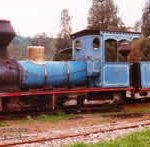
Status: Under restoration
This 0-6-0 tender locomotive was built in Leeds, England by Hudswell Clarke in 1915, and is similar to many of this make which operated on sugar cane tramways in Queensland. It first worked at Childers Mill, where it was given the number ‘7’ on the locomotive roster, which it was to retain throughout its working life. In 1932 it was sold to the Isis Central Mill and, in 1960, it passed into the hands of the Gin Gin Mill. In 1970 it was purchased by Bruce MacDonald who restored it at the Goulburn Steam Museum. The locomotive was transferred to the Old Brickworks Museum at Yarralumla in the ACT in 1978.
Hudswell Clarke 1098 was obtained by the Alexandra Timber Tramway in 1981, and was operated on a short length of track at Alexandra. However, it proved to be too heavy for the sharp curves and 30lb rail in use at the time, and was retired for an overhaul in favour of the lighter John Fowler 0-6-0T locomotive. The track has since been rebuilt with 60lb rail, and it is intended to return the Hudswell Clarke to service as a priority project.
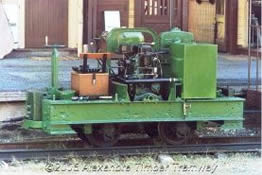
Non Steam
- Cheetham Salt No.1 (L6)
- Day’s rail tractor (JS Lee & Sons)
- Day’s rail tractor (Ruoak Timbers)
- Day's Tractor ex Cheetham Salt
- George Sewell 4wDM
- Kelly & Lewis 0-6-0DM 4271 of 1935
- Kelly & Lewis 0-6-0DM 5957 of 1936
- Kelly & Lewis / Caldwell Vale 4wDM loco "Flora"
- Malcolm Moore rail tractor no 23
- Malcolm Moore 4wPM 1049 of 1943
- Malcolm Moore 4wPM C.396 of 1946
- Malcolm Moore 4wPM "TACL" built mid 1920s
- Matisa Tamper 7665 of 1967
- SEC2 4wPM ganger's trolley
- Motor Rail "Simplex" 4wDM 7351 of 1938 (L7)
- Motor Rail "Simplex" 4wDM 10058 of 1948 (L5)
- Whitcomb 4wDM 40521 of 1947
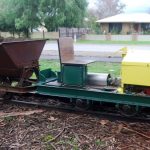
Status: Operational
This locomotive is the sole survivor of three constructed in Cheetham Salt Limited’s Laverton workshops about 1962 to transport beach sand to reline the salt pans at the end of each harvest. Originally fitted with a Ford engine, it was rebuilt about 1974 and refitted with a Morris engine. It was still working in 1976 but, by 1986, had been abandoned on an outer siding of the Laverton Salt Works. The locomotive was purchased by ATT member Peter Evans and transported to Alexandra on 8 September 1988.
The locomotive was moved off-site to commence restoration in April 2003 and, by the end of that year, the locomotive had been stripped down to a bare frame, motor and transmission. Multiple repairs to components have been carried out, all woodwork replaced, the engine and transmission rebuilt, and the locomotive was repainted and operational in June 2016.

Status: Awaiting restoration
This 3-ft 6-in (1067mm) gauge 4wPM locomotive started life as a standard 3-ft (914mm) gauge 0-6-0PM Day’s rail tractor with an as yet unknown owner at an as yet unknown location. Around 1947, it was purchased by J. S. Lee & Sons of Leesville in north-west Tasmania and the power plant was replaced, converting it into a 3-ft 6-in gauge 4wPM. It may have had up to two replacement power plants during its Tasmanian working life and, as it is now, weighs about 4.5 tonnes. Its main job was to haul sawn timber from the Leesville sawmill 3km along a remnant of the Marrawah Tramway to the TGR sidings at Smithton. It was also used to shunt TGR wagons around the yard using a pole and a heavy rope. The loco is powered by a Ford V8 engine driving a large reversing box mounted at the rear of the tractor. Power is transmitted to the rear axle by chain drive, with power being transmitted to the front wheels by an additional chain on the left-hand side of the loco. In 1974 the mill was closed and the Day’s tractor fell into disuse. (Many thanks to Tony Coen for information and for permission to include the colour photograph of the locomotive working the yard at Smithton in 1968).

Status: Operational
Rail tractors were popular with Victorian sawmillers. They were generally cheaper than a steam locomotive, required no special qualifications to drive, and used proven power plants for which spares were available locally. This particular tractor was purchased by Ruoak Timbers in 1940 to work the outlet tramway from its No.4 and No.5 mills high in the Royston Valley, replacing twenty horses and five men. The tractor was built to the rather unusual gauge of 3-ft 4½-in (1049mm) to conform with the gauge of the Rubicon Forest tramways. The tractor was constructed by Day’s Engineering of South Melbourne which, although better known for its pumping equipment, built more than fifty rail tractors for Victorian sawmillers and other industrial tramway users. The rail tractor remained in use until about 1952, when all tramway transport was abandoned, and the tractor was removed from the bush and put into storage at Ruoak’s Alexandra mill. In 1981, it was donated to the Alexandra Timber Tramway and was the first locomotive to be restored to operating condition at the Museum.
This rail tractor is almost complete as built, the only item replaced being the roof (the uprights are original). Today, only four timber tramway tractors built by Day’s survive (an incomplete example at Erica, a heavily modified example at Marysville, and the two at Alexandra). This is the only one in operational condition. Note the wide wheel treads and deep flanges for operating on roughly-built tramways. Although this tractor was designed to run on wooden rails, in practice it was found that the tractor derailed frequently until the line was progressively re-laid with steel rails.
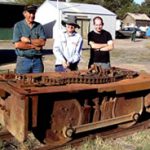
Status: Awaiting restoration
W. Day & Sons is believed to have constructed its first light railway locomotive in 1926. From then until the mid 1940s, the firm appears to have built at least fifty locomotives at its premises in South Melbourne, of which roughly half were four-wheel locomotives and roughly half were six-wheel locomotives like the restored Day’s rail tractor formerly operated by Ruoak Timbers. Of the four-wheel locomotives, ten were 2-ft (610mm) gauge locomotives similar to this one. Today, only two survive, a complete example at the Puffing Billy Railway Museum at Menzies Creek, and this example.
This 2-ft gauge 4wPM locomotive is believed to have been formerly used by Cheetham Salt, possibly at the Moolap works near Geelong and, eventually, going to Tasmania. It ended up at the Redwater Creek Steam & Heritage Society at Sheffield, where it was surplus to requirements and was donated to the Alexandra Timber Tramway. The Day’s tractor is complete as a rolling chassis but is minus the engine (an International tractor unit similar to that on our ex-Ruoak six-wheeled Day’s tractor). We are now on the lookout for a suitable engine unit to enable the restoration of this rail tractor to operating condition.

Status: Operational
This small diesel locomotive numbered 18-C-25 was used on the maintenance tramway at Waranga Basin Reservoir between 1959 and 1994. The reservoir was built between 1902 and 1908 as part of an irrigation scheme for central and northern Victoria. The State Rivers and Water Supply Commission of Victoria was constituted in May 1906 by the amalgamation of many of the small rural water supply and irrigation trusts in Victoria. Presumably, the SR&WSC took over the construction work shortly after its formation. The Waranga scheme was enlarged between 1915 and 1926. It is highly likely that tramway systems had been used since the start of construction as it was the most efficient technology of its day. The purpose of the tramway system was to haul beaching-stone from nearby quarries to prevent erosion of the wall by wave action. Once the wall was completed, the tramway was used intermittently for maintenance purposes, especially during 1935-36 when the wall was damaged by storms. The tramway was re-laid in heavier rail in 1936-38.
Photographs suggest that the first motive power on the tramway was horses. This locomotive was purchased to supersede horse-traction. It was built in 1959 for the State Rivers and Water Supply Commission by S.G. Sewell, nut and bolt manufacturers of Brunswick, very likely on an underframe built earlier by G.F. Sewell of Footscray. The locomotive consisted of a skip frame with a petrol engine driving the axles via roller chains. The original engine was replaced by a Petter diesel in 1971-1972. The tramway along the top of the wall was cut back during the latter years of operation, and was removed entirely during April/May 1995. The “feeder” section from the western end of the wall to the quarry is still largely intact, and is to be preserved in-situ. The locomotive is displayed with three of the wagons that it hauled in service.
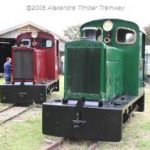
Status: Operational
The tramway between Rubicon and Alexandra was opened in 1912 by the Rubicon Lumber & Tramway Company, and was operated by small steam locomotives until 1935, when the lease on the line was to be renegotiated. The Rubicon Lumber Company was outbid by rival sawmillers Clark & Pearce, and the line changed hands. The new lease was to take effect at the beginning of summer, when steam was to be banned on the tramway for the first time because of the fire risk. Geo. W. Kelly & Lewis Pty Ltd of Springvale, Melbourne, was commissioned to build an 0-6-0 diesel locomotive. The locomotive weighed ten tons and was powered by a four-cylinder Dorman-Ricardo diesel engine. It was painted green, and carried the builder’s number 4271. It was the first diesel locomotive to be built in Victoria, and cost £2750.
The locomotive entered service on Monday 3 December 1935. A special ceremony was held at Rubicon on Saturday 14 December, at which the locomotive was named “The Pioneer” by Mrs. Dobson, wife of the Alexandra Shire President. A second locomotive (5957, painted maroon) was purchased in 1936. The tramway on which this pair of highly successful diesel locomotives ran was closed in 1947, and the locomotives were retired. In 1985, the Alexandra Timber Tramway & Museum was incorporated as the successor to the Alexandra & District Historical Society. Locomotive 4271 was vested in the new body, and finally returned to service on 12 December 1993.
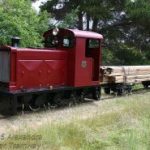
Status: Operational
In 1935, Rubicon sawmillers Clark & Pearce purchased the first diesel locomotive to be built in Victoria, Kelly & Lewis 4271. With the annual output of the Rubicon Forest increasing, Clark and Pearce ordered a second diesel locomotive from Kelly & Lewis on 28 January 1936. The new locomotive carried the builder’s number 5957, was painted maroon, and cost £2600. The first diesel had proved so successful that few changes were made.
The tramway on which this pair of highly successful diesel locomotives ran was closed in 1947, and the locomotives were retired. The pioneer locomotive 4271 was stored inside the locomotive shed, while 5957 lay outside in the weather, partially dismantled for an overhaul that never eventuated. In 1985, the Alexandra Timber Tramway & Museum was incorporated as the successor to the Alexandra & District Historical Society. Locomotive 4271 was vested in the new body and 5957 was sold to collector Paul Simpson in NSW. After many years of effort, Paul restored 5957 to working order, and then assisted the Alexandra Timber Tramway in the restoration of 4271. The happy result was that, by 1992, both locomotives survived in operational condition, albeit many hundreds of kilometres apart. Paul Simpson passed away on 23 June 2003. The Alexandra Timber Tramway purchased 5957 from his estate with the aid of funds from a Commonwealth-funded “Regional Partnerships” grant, a grant from the Shire of Murrindindi, and transport donated by J. L Gould Sawmills Pty Ltd. The ATT contributed materials and labour to extend the locomotive shed and to cosmetically restore 5957. The locomotive arrived in Alexandra on 16 July 2004 and has since had a mechanical overhaul and a complete repaint, with many missing fittings being restored.
Both locomotives are of National Heritage Significance. They were the fourth and fifth diesel locomotives constructed in Australia, the first and second constructed in Victoria, and are the oldest extant Australian-built diesel locomotives.
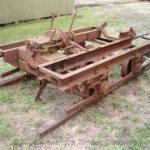
Status: Awaiting Long-term restoration
This locomotive frame was built by Kelly & Lewis of Springvale, Victoria, on behalf of Caldwell Engineering (Australia), of Marrickville, New South Wales. The locomotive was one of two constructed to the order of the NSW Metropolitan Water Sewerage & Drainage Board for use on the construction of the Captain Cook Graving Dock (Sydney) in the early 1940s. This particular locomotive was known as FLORA, and its running mate was known as GWEN. Both were fitted with Fowler brand radiators, presumably having Fowler diesel engines.
FLORA was noted in use at the Graving Dock in 1942, and was still there in 1944. Its whereabouts after this is currently not certain until around 1961, when it was used in the dismantling of the NSW Government Railways branch-line between The Rock and Westby, which was formally closed in 1961. When it arrived at The Rock, it is reputed that the contractor did not realise that railways were sometimes of different gauges, and that it could not be used in its present form. The loco was converted 4ft 8½in (1435mm) gauge by cutting the axles in half and using tube steel to make up the difference, and by widening the frames. By this time a new engine had been fitted.
After this, it appears that the loco remained at The Rock until obtained by Upton Engineering of Corowa for parts or scrap. The engine and radiator were removed along with the cab. In October 1987, it was obtained by a private collector and moved to a property at Belgrave South around June 1993. The ATT&M purchased the remains of this loco in June 2005, and it arrived at Alexandra in April 2006. When time and funds permit, the Alexandra Timber Tramway intends to convert the loco back to 2ft (610mm) gauge and restore the loco to operating condition in as near-built condition as possible.

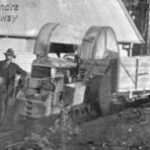
Status: Static Display
The ballast and buffing weight displayed at the ATT is all that remains of the first locomotive used on the Rubicon hydro-electric scheme. This locomotive was built by Malcolm Moore at its Port Melbourne workshops and assigned builder’s number 23. It was powered by a Fordson tractor unit powering the loco’s rear axle by a drive from the tractor rear axle (covered by the large sheet-iron covers at the rear of the loco). The rear axle was then coupled to the front axle via a roller chain. Only the normal Fordson gearbox was used, so the loco had three speeds in forwards but only one in reverse. Very little of the tractor was wasted – even the rear mudguards were used to form part of the cab. The locomotive was in use during construction of the scheme, and for many years afterwards was used to haul trains on the raceline maintenance tramway. Being difficult to start, it was not well liked by its operators, and was eventually replaced by a Malcolm Moore “1000” series locomotive powered by a Ford V8 engine. This was a much more sophisticated unit and, except for the cab and the colour, identical to Malcolm Moore 1049 on display at the Alexandra Timber Tramway. Malcolm Moore No.23 was consigned to the scrapheap and its driver at the time, Ernie Le Brun, was glad to see it go.
Because the heavy cast iron weights fitted to the locomotive front and rear made re-railing the locomotive difficult (and derailments were relatively frequent), Ernie had them removed while the locomotive was still in service. One of these weights slid down the hillside and thus escaped being sold off as scrap. Some years ago it was rediscovered by an SEC employee near the top of the haulage at Rubicon, and has been kindly donated for display at the ATT.


Status: Operational
After Pearl Harbor and the rapid advance by the Japanese towards Australia, local industry was placed on a war-footing. It was in this context that a total of ninety-two Malcolm Moore V8 locomotives were designed and constructed for the Australian Army. The use of Ford V8 engines as a power source was a logical choice, as this was a unit favoured by the army for a wide range of vehicles. This engine was considered by troops to be the most reliable available. Its use in large numbers of vehicles, both Australian and American, meant spares were always to hand. Its ease of service and accessibility meant that damaged vehicles could easily provide parts to keep other vehicles in running order. As it turned out, very few of these locomotives were used in war service, some being sold still in their boxes in the 1970s. The American policy of ‘island hopping’ (and comparatively ample supplies of road vehicles) meant that a different approach to handling materials was used.
No. 1049 was sold by the Department of Supply to the State Electricity Commission of Victoria where it was probably used on one of the construction railways of the Kiewa hydro-electric scheme in the 1950s. The SEC later moved it to Yallourn, where it was used on a boiler ash disposal line. The loco was withdrawn from service in December 1974 and eventually moved to the Gippsland Folk Museum at Moe. The Alexandra Timber Tramway swapped the locomotive and its associated side-tipping skips for an old motor vehicle, and 1049 was restored to operating condition by Ian Bowering at the Alexandra Hospital. In February 2003, the chassis of Malcolm Moore 1023 was inserted under 1049’s cab and power-plant due to excessive wear on the wheels of 1049. Two other Malcolm Moore locomotives of this type in various stages of restoration can be seen at the ATT. These will be completed as time and finances permit.
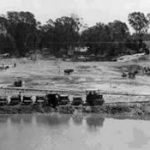

Status: Awaiting restoration
This 3-ft 6-in (1067mm) gauge Fordson tractor-powered rail tractor was one of three built by Malcolm Moore of Port Melbourne for the Victorian State Rivers and Water Supply Commission in 1946, being the second rail tractor supplied under the contract. It was used on enlargement works at the Hume Dam near Albury. The Hume Dam was proposed and started in 1919. It took seventeen years to build, opening in 1936, at which time it was the largest dam in the British Empire and the third-largest world-wide. The irrigation potential it unleashed was such a success that the dam was enlarged in the 1950s, submerging the town of Tallangatta. It was during this period that the Malcolm Moore rail tractors were used. When full, the Hume Weir holds more water than Sydney Harbour, and has become a popular recreational and water sports attraction.
The three Malcolm Moore rail tractors (plant numbers 18-C-6, 18-C-7 and 18-C-8) were advertised for sale by auction at Bendigo on 15, 16 and 17 July 1958 along with a large number of other items of equipment. This particular rail tractor was subsequently obtained by the Bellarine Peninsula Railway (south of Geelong), and used on the re-gauging of the railway to 3-ft 6-in. The Malcolm Moore was transferred to Alexandra under a lease agreement on 3 July 2003. It is believed to be the sole survivor of its class.
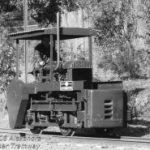
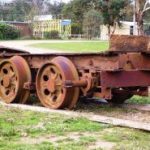
Status: Awaiting Long Term Restoration
This locomotive frame was once a 3-ft (910mm) gauge rail tractor owned and operated by the Mount Horsfall Sawmilling Company, formed in 1923 by father and son Benjamin and Philip Davis to exploit timber growing on private property on the ridge separating the Yarra and Latrobe watersheds. Two sawmills were installed, and an expensive outlet tramway constructed from the mills down the steep valley to join with the Loch Valley tramway to Noojee. The Company soon lost the rights to the timber it was hoping to cut cheaply to a rival sawmiller, and quickly found itself in financial difficulty. A rescue plan involving the injection of additional capital by Henry Jones IXL was thwarted when, in February 1926, bushfire swept the area, destroying one of the mills and the Loch Valley tramway on which the Company relied to get its timber to Noojee. The firm went into liquidation in September 1927.
B. J. Davis Pty Ltd was formed with a large creditor shareholding to take over the assets of the former company and try and rescue something from the mess, but the stipulation by the Melbourne & Metropolitan Board of Works that no sawmilling be permitted in its recently-acquired Upper Yarra catchment soon put an end to even this rescue package. The mill plant was abandoned in the bush and progressively stripped by thieves of small items of value before the area was once again burnt in 1939. The firm’s rail tractor was discovered during roading operations in the early 1980s and removed from the bush by the Forests Commission.
This rail tractor is clearly of the 4wPM “TACL” (Tractor Appliance Company Limited) type. The TACL tractor appears to have originated in the USA when the Brookville Locomotive Company of Pennsylvania began construction of small locomotives based on Ford truck power plants in 1917. By January 1926, the Company was selling a chain-drive rail tractor based on the Fordson tractor power plant with three speeds in both directions. In Australia, the idea was adopted by Malcolm Moore of Port Melbourne and sold under the TACL name. This rail tractor is quite different from the three other preserved TACLs known, and may be the earliest known version of the type. Perhaps its closest “relative” is the fully-restored TACL tractor owned and operated by the Puffing Billy Preservation Society and shown in the black and white photograph.
Unfortunately, the frame is too bent for the tractor at Alexandra to be easily restored, and it is likely to remain a static exhibit for the foreseeable future.
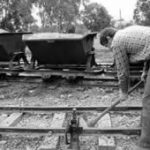
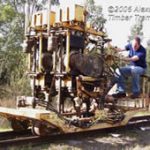
Status: Operational
Stone “ballast” is an essential item in railway construction. It forms the bed on which the track is laid, and allows moisture to drain away from the sleepers. Over time, constant traffic causes “voids” to appear in the ballast which need to be filled to maintain the stability of the track. In the past, this has been done using rail jacks and a hammer-headed pick-like device known as a “ballast pick”. This is slow and labour intensive, as any of our volunteers who has swung a ballast pick under the Alexandra sun will testify. This job is known as “tamping” the ballast. A tamping machine works by mechanically vibrating the ballast and forcing it under the sleepers. These combined actions cause the ballast to form a close matrix which can support the track more effectively.
Material Industriel S.A. (Matisa) was formed in Switzerland in 1945 and pioneered the mechanisation of track-work, becoming famous world-wide for its ballast tampers. This particular tamper, type BL09M and builder’s number 7665, was built in 1967 for the Australian Army. It is not known where and if it saw use with the Army, but it spent most of its working life as part of the track plant at Cattle Creek sugar mill in Queensland. It later spent some time at a tourist railway near Porepunkah before being purchased by the Alexandra Timber Tramway. It arrived on site in September 2000. The tamper is powered by two diesel engines which drive the tampers and the hydraulic motors which allow the machine to move along the track under its own power.

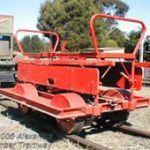
Status: Operational
This, the smallest of the self-powered items of rolling stock at Alexandra, started life as a 5-ft 3-in (1600mm) gauge Victorian Railways ganger’s trolley. It is powered by a “Commando” single-cylinder petrol engine which can be started to run in both directions, eliminating the need for a gearbox. Final drive is via a belt to the wheels.
At some stage the trolley found its way to the State Electricity Commission’s 3-ft (914mm) gauge Bogong Creek raceline tramway as part of the Kiewa hydro-electric scheme. With the line being at an altitude of 700m, it must have been a cold job in winter for its operator. It was eventually discarded in favour of inspection vehicles with a greater degree of protection for the driver.
The trolley was purchased by Denys Steinhauser of Kiewa, re-gauged to 2-ft (610mm), and sold to a member of the ATT for use at Alexandra. The trolley, being designed for the broad gauge and straight runs, can be very “exciting” to ride on the sharp curves at Alexandra. It has only one speed – very fast – and, as such , is only used when there are enough volunteers willing to “ride the trapeze” on the inboard side of the curves. No member of the public is allowed on board!
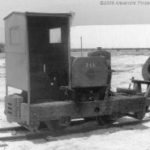
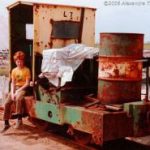
Status: Dismantled, awaiting long-term restoration
The First World War saw the first ready acceptance of the internal combustion locomotive for service on the light railways supplying the front. Unlike a steam locomotive, the internal combustion locomotive did not betray its presence by a column of smoke and steam. The Motor Rail & Tramcar Company of Bedford’s “Simplex” locomotives did more than any other type to popularise the breed. These locomotives were almost entirely petrol-engined but, post-war, were fitted with what would now be accepted as a conventional compression-ignition (diesel) engine. “Simplex” locomotives continued to be popular post-war, and were sold in a wide variety of gauges, weights and powers.
“Simplex” 7351 was built in 1938 and delivered to Diesel Locomotive Hirers Ltd, a subsidiary of Motor Rail. By 1950 it had made its way to Australia, where it was fitted with a replacement Dorman diesel engine and used by J. Howard & Co. on the construction of Kings Wharf at Geelong. By 1953, J. Howard & Co. had moved the locomotive to Belgrave, where it was used to build the approaches for a new road bridge over the point where the broad-gauge suburban electric railway meets the tracks of Puffing Billy. At some stage after this, it was sold to Cheetham Salt Ltd, where it ended its many years of industrial service on the salt tramways at Laverton.
In 1987, Motor rail “Simplex” 7351 was purchased by ATT member Peter Evans and moved to Belgrave South where it was dismantled. As the frame of 7351 was found to be severely affected by rust, the engine from 7351 was removed, restored, and fitted to Simplex 10058, which had been obtained without an engine. The spares obtained with 7351 from Laverton included almost enough parts to build a complete engine so, at some point in the future, 7351 will become a retirement project for its owner and will be restored to operating condition at Alexandra.
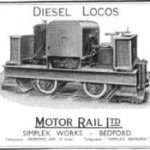
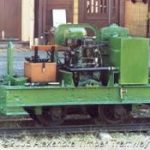
Status: Operational
“Simplex” 10058 was ordered in 1948 by Melbourne agents Marfleet & Weight for the State Rivers & Water Supply Commission’s Tarago aqueduct tunnel (used for the supply of water to the Mornington Peninsula). After the completion of the tunnel, the locomotive was purchased at auction in August 1957 by Cheetham Salt Limited for £320. The locomotive was then used at the Laverton salt works to haul salt from the evaporating pans to the works stockpile.
In June 1986, 10058 was purchased by ATT member Peter Evans from Cheetham’s Laverton works in an engineless, derelict condition. Work had already started on cutting-up the locomotive for scrap, with the frame cut completely through in six places. “Simplex” 10058 was fitted with the engine from sister locomotive 7351 of 1938, and was returned to service at Alexandra in early 1992. The site of the former Laverton salt works is now the Sanctuary Lakes housing development and there is very little sign of the once extensive salt works tramway system.


Status: Awaiting Restoration
This locomotive is a Whitcomb 4wDM, model 5DM26A, builder’s number 40521, built in 1947 to the gauge of 60cm for a large 1946 order from the French Supply Council. The locomotive was originally powered by an International Harvester UD6 engine. Whitcomb 40521 is reputed to have been used on the Snowy Mountains hydro scheme, and perhaps arrived in Australia around 1955 with the joint venture of six French contractors (including Etudes et Entreprises and Citra) responsible for the Upper Tumut pressure shaft, T1 power station and the tail-water tunnel. At some stage after this work was finished in 1959, the loco was sold to Upton Engineering of Corowa, where the engine was removed for use elsewhere.
In 1987 the locomotive was sold to a machinery collector and moved to Belgrave South, where it lay for some years. It was purchased by the ATT in June 2005. We have a suitable “International” petrol engine to power this locomotive and, if we can find a matching transmission, this should make an excellent operational loco with very little other work than the replacement of some of the cab structure and the roof and a coat of paint. Only three other Whitcomb locomotives are known to have been used in Australia: 11734 of 1924 (3-ft or 914mm gauge) used at David Mitchell Estate in Lilydale, and 61108 and 61109 (5-ft 3-in or 1600mm gauge) used at APM Maryvale. Whitcomb 40521 is the only preserved Whitcomb locomotive in Australia.

